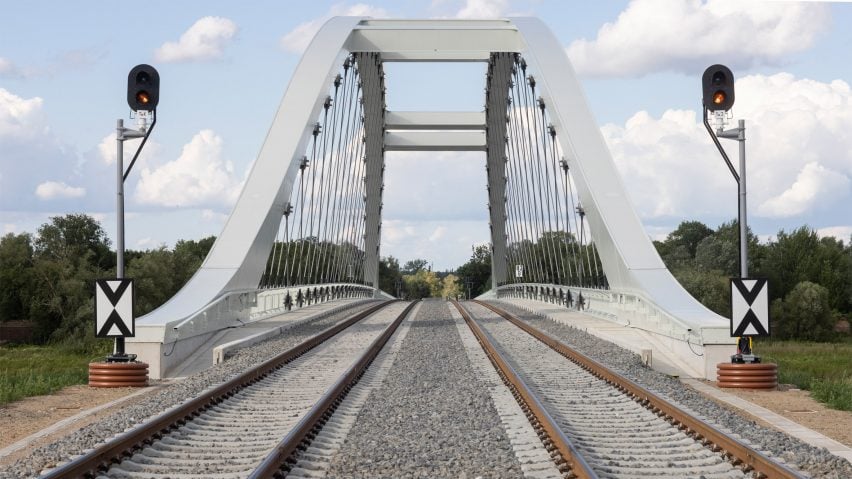London studio Knight Architects has completed the Küstrin-Kietz Rail Crossing bridge, which is framed by white steel arches and a tensile lattice of carbon-fibre reinforced plastic.
Crossing the River Oder over the demarcation line between Germany and Poland, the 266-metre-long bridge restores a historic rail link between the two countries that dates back to the early days of European railways. Its main span is 130 metres.
Won via an international competition alongside civil engineers Schüßler-Plan with structural engineer Schlaich Bergermann Partner (SBP) coming on board shortly after, the project is comprised of two bridge structures as well as the restoration of a stretch of railway track.
The main railway bridge replaces a derelict single-track truss with a larger, two-track bridge, while a smaller bridge to the west of the main crossing spans a flood relief canal.
Opting for a minimal design, Knight Architects envisioned the bridge as a unifying symbol for the two countries, with the apex of its arch sitting directly on the border line at the centre of the river.
"The design itself had to be respectful to both nations, precluding an asymmetrical cable-stayed design as we wanted to create something that represented equality on each side," Knight Architects director Bart Halaczek told Dezeen.
"As a result, we created a simple, clear, elegant and symmetrical design solution that also serves as a gateway that welcomes the visitor, enhancing the sense of place — while also improving connectivity between these two nations to generate lasting value."
Brick-clad concrete piers support the bridge on the river's banks, while across the centre the 130-metre span is supported by arches in white steel and lightweight tensile elements.
According to the SBP, the bridge is the first in the world to be hung entirely on tension elements made from carbon-fiber reinforced plastic (CFRP), reducing the amount of concrete and steel and therefore reducing the weight of the bridge significantly.
"The bridge structure is a so called 'network arch', in principle similar to the Ordsall Chord in Manchester," Halaczek explained. "The system looks like a tied-arch, but the hangers are inclined in their plane, adding up to a grid."
"Those systems allow a reduction in cross sections of the main structural elements, especially visible in the filigree arch," he added.
Knight Architects was founded by architect Martin Knight in 2006. Previous bridges by the studio include a London footbridge that opens and closes like the blades of a traditional hand-held fan.
The photography is by Wilfried Dechau.

